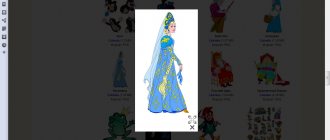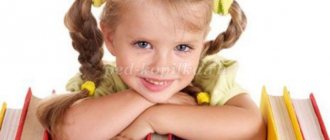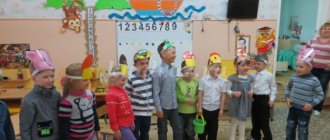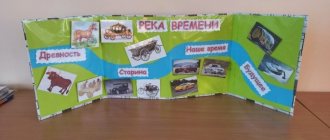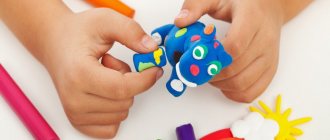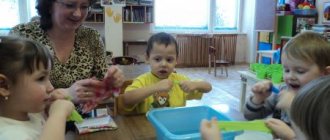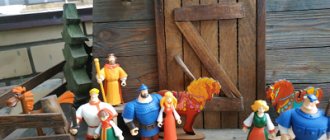Project “Creative workshop “Kaleidoscope of Creativity” in a pre-school group
Nadezhda Kitaeva
Project “Creative workshop “Kaleidoscope of Creativity” in a pre-school group
Municipal preschool educational institution
"Kindergarten No. 20 combined type"
Project
“Innovative forms of working with parents
within the framework of innovation activities
“A piggy bank of creative ideas -
creative workshop “ Kaleidoscope of creativity ”
(school preparatory group)
Compiled and developed by:
N. A. Kitaeva, teacher
Saransk — 2020
The development creativity is carried out in kindergarten in various ways: in the process of artistic, productive and theatrical activities, in the process of play and experimental activities. to develop the creative abilities of children without the participation of parents. The family is a unique and so far the only social institution for raising children, one of the functions of which is the formation of the child’s personality, the development of his abilities and interests.
During the work, it became clear that parents take a contemplative position in relation to the creativity of their children . The usual questions from parents were: “What do you draw?”
,
“What kind of figure is this?”
Artistic and aesthetic development is an important aspect of family education; primary artistic feelings, tastes and aesthetic views begin to form in the family.
Preschool institutions are designed to help parents receive qualified information and assistance in creating a favorable environment at home, to instill in parents an interest in artistic creativity and to develop the ability to use certain methodological techniques for introducing children to the fine arts, taking into account the individual and psychological characteristics of children.
Most forms of work are aimed at attracting parents to active and repeated participation in working with children. The principle of equality of positions is based on the fact that children have an undeniable impact on their parents. As practice shows, the most interesting and creative work comes from those parents and children who satisfy the child’s needs, take into account the child’s capabilities, and realize the child’s interests. Gradually, the position of parents in a preschool institution changes from a passive participant to the position of an active participant in the educational process.
At a certain stage, the family unites with the kindergarten and forms the main educational space for the child. Consequently, the importance of family education in the process of children’s development also determines the importance of interaction between the family and the preschool institution . Both the family and the preschool institution convey social experience to the child in their own way. But only in combination with each other do they create optimal conditions for a little person to enter the big world.
How can we draw the attention of parents to the importance of communication, mutual understanding with their child, and teach them to see the adult personality in the child? How to achieve this?
I came to the conclusion that the most acceptable innovative form of working with parents on the artistic and aesthetic development of children in the preschool group is the “ Kaleidoscope of Creativity ”
.
"
Kaleidoscope of Creativity " is
a creative workshop . A creative workshop can be classified as a non-traditional educational and leisure form of organizing relationships between teachers and parents.
Why a creative workshop ? This form of working with parents helps solve several problems at once:
1. Such meetings provide an opportunity to expand the ideas of parents of pupils about creative activities and introduce them to art; show working methods (traditional and non-traditional)
with various materials
(salt dough, plasticine, paints, sand, cereals, paper, etc.)
2. The creative union of parent and child, their close communication in a creative atmosphere makes it possible to look at the relationship with your child in a new way. Develops and improves parent-child relationships based on substantive joint activities.
3. Develops the emotional sphere of children:
• teaches you to rejoice in the success of others;
• the joy of giving handmade crafts;
• tolerance.
4. Helps establish emotional contact between teachers, parents, children, and relationships between generations.
Thus, a creative workshop , as one of the forms of interaction between a kindergarten and parents, helps not only to establish emotional contact with parents, improve child-parent relationships based on substantive joint activities, but also to become a kind of club for children and parents.
The completed works of children, together with their parents, are used in the design of other meetings, exhibitions, as gifts for adults and children, in organizing competitions, and more.
The motto of our creative workshop is “Learning to create with children ”
.
Novelty of the project : a system of working with parents on the artistic and aesthetic development of children of senior preschool age , taking into account the specifics and educational potential of each family.
the school-preparatory kindergarten group has been developed and put into practice ; GCD notes, consultations, recommendations, and booklets have been developed.
Leading goals and objectives of interaction between the kindergarten and the family:
Goal: to promote the optimization of partnerships and cooperation between preschool educational institutions and the families of pupils through the development of the creative abilities of children of senior preschool age .
Tasks:
1. Contribute to the establishment of partnerships with the family of each pupil;
2. Create an atmosphere of mutual understanding, community of interests, emotional mutual support;
3. Contribute to the formation of artistic taste;
4. Activate and enrich the experience of parents and children with various techniques and methods of working with art materials;
5. Ensure the involvement of families in direct educational activities, including through the creation of educational projects together with the family based on identifying needs and supporting the educational initiatives of the family.
Therefore, the object of this work is pedagogical education of parents of preschool children , and the subject is the content and forms of pedagogical education. After all, no matter how seriously the forms of raising children in preschool institutions , no matter how high the qualifications of the employees of a preschool institution , it is impossible to achieve the goal without the constant support and active participation of parents in the educational process
Hypothesis: When implementing an innovative form of cooperation with the family, a new system of interaction between the preschool educational institution and parents will be created, which will allow for the education and development of preschool children through the joint efforts of the preschool educational institution and the family and eliminate formality in working with parents.
implementation period is long-term (2020 – 2022 academic year)
preparatory group children , teachers, parents, grandparents.
Main forms of project :
— participation in events, exhibitions, preparations for holidays ;
- joint activities between parents and children;
— consulting.
Stages:
The first stage is preparatory (preparing visual information, working with children, parents and teachers).
The second stage is organizational and practical (determining forms of work with parents in a group , planning stages of work for the year on interaction with parents, analysis, processing of materials for the project )
The third stage is final (summarizing, conclusions)
.
Expected results:
— maximum disclosure of each child as a unique individual;
— productive interaction between teaching, parent and child communities;
— implementation of educational services taking into account the personal interests and needs of children, parents and teachers.
Literature:
1. O. I. Davydova. A competency-based approach in the work of a preschool educational institution with parents. _ SPb.: PUBLISHING HOUSE “CHILDHOOD-PRESS”
, 2013;
2. O. I. Davydova, A. A. Mayer, L. G. Bogoslavets. Projects in working with families . Toolkit. M.: TC Sfera, 2013;
3. A. A. Mayer, O. I. Davydova, N. V. Voronina. 555 ideas for involving parents in the life of a kindergarten. - M.: TC Sfera, 2012;
4. Family and parent clubs in kindergarten. Methodical recommendations / ed. N.V. Miklyaeva. - M.: Sphere shopping center, 2012.
Technologies for interaction with parents
on artistic and aesthetic development
children in older preschool age
The involvement of parents in a single space for the artistic and aesthetic development of children in kindergarten is built in two directions:
— improving the pedagogical culture of parents;
— involving parents in the activities of preschool educational institutions through joint work to exchange experiences.
To implement the first direction, taking into account the current epidemiological situation, I will use the following forms of work:
— Visual propaganda – the use of such means of visual propaganda: booklets, memos, information on the preschool educational institution’s website, consultations;
— Information and practical forms of working with parents: conferences, parent meetings.
To implement the second direction, non-traditional forms of work with parents will be practiced, including interactive ones:
- actions - a set of activities that help parents better understand the problem, determine their attitude towards it and their position in solving it;
- master classes for parents are a transfer of current technology, a way of interaction with a teacher, ensuring the transfer of parental experience, skill , art through direct and commented demonstration of working techniques;
— photo exhibitions, competitions, creative workshops .
Assessing the effectiveness of educational activities with children and parents on artistic and aesthetic development
children of senior preschool age
The criteria for the effectiveness of working with parents, according to O. L. Zvereva, include:
- expression of parents’ interest in the content of various forms and methods of interaction between the kindergarten and the family (gratitude, questions, need for further cooperation)
;
- the emergence of discussions on the initiative of parents;
- attracting the experience of parents;
- the emergence of reflections on the correctness of methods, recognition of one’s mistakes;
— increasing the activity of parents when participating in events, analyzing pedagogical situations.
Determining the effectiveness of interaction between kindergarten and family is carried out using a survey.
Long-term plan for working with parents
“A piggy bank of creative ideas -
creative workshop “ Kaleidoscope of creativity ”
in preparatory school group No. 8
Time of the event Form of organization, topic Purpose of the event
September Parent survey
on the artistic and aesthetic development of preschool children . Identify ideas on the problem of artistic and aesthetic development by preschool children . To determine the degree of awareness of parents about the role played by artistic and aesthetic development in the upbringing of a preschooler .
October “Ladushki, ladushki – grandfathers and grandmothers”
Volumetric applique “Portrait of Grandmother and Grandfather”
To promote the development
of creative interaction between children and parents.
December Making and painting New Year's gingerbread To promote the formation of deep and trusting relationships between children and parents in the process of joint artistic activity while learning about the history of the origin of gingerbread, making and painting gingerbread.
January “Making a family amulet “Horseshoe for good luck”
Involving children and parents to participate in joint
creative activities through familiarization with amulets, their meaning in people's lives, the production and design of amulets.
March Virtual photo exhibition “Mom’s Hobby”
To promote increased interest in family traditions, artistic, decorative
creativity , handicrafts of one’s mothers and strengthening family ties.
April "Easter Egg"
- papier mache
To help reveal the secrets of using waste material to make various forms; act together with children, plan activities, discuss plans, share responsibilities.
May Easter gingerbread To promote the development of interest in children and parents in this type of folk art and decorative art, such as modeling from salt dough; developing practical skills in decorating puff pastry products.
Questionnaire for parents
on artistic and aesthetic development of preschool children
Goal: To identify ideas on the problem of artistic and aesthetic development by preschoolers . To determine the degree of awareness of parents about the role played by artistic and aesthetic development in the upbringing of a preschooler .
Dear parents!
Please answer the questions provided in the questionnaire. Your sincere answers will help to study the problem in more depth and outline ways to improve the pedagogical process of our group .
1. At what age do you think the targeted artistic and aesthetic development of a child is necessary?
2. What types of children's productive activities are most interesting to your child? Do you consider it mandatory to attend in preschool age : drawing, modeling, appliqué, artistic work, design. ?
3. Does your child often draw, sculpt, design, or make appliqué?
4. Does your child often pay attention to “beauty”
the surrounding world (nature, beautiful little things in everyday life, etc.?
5. How does a child usually behave when he notices something beautiful?
6. How does your child’s desire for beauty manifest itself?
7. Does your child ask questions about art? Does he ask you to explain some words (for example, what is art, landscape, sculpture, etc.)
8. Does your child ask to buy new paints, pencils, plasticine, markers ?
9. When your child brings work from kindergarten, who does he try to show it to, how does his desire or unwillingness to show his work manifest itself?
10. Are you involved in any artistic activity or craft?
11. Do you involve your child in your activities, and in what form? 12. Name the difficulties that arise in the process (drawing, sculpting, appliqué or design)
your child?
13. Are you ready to take part in any events organized in kindergarten in the direction of the artistic and aesthetic development of children (joint with children, making costumes, drawings in creative competitions ? Which ones?
14. Formulate your wishes to preschool teachers in terms of organizing, conducting, and content of work on the artistic and aesthetic development of children?
Help and analysis on parent surveys
20 parents took part in the survey; parents were asked to answer 14 questions.
Conclusions: As a result of the survey, it was revealed that parents are generally aware of what artistic and aesthetic development is.
66.7% of parents know what it is.
13.3% of parents find it difficult to answer this question.
To the question “Wishes to teachers in terms of organization, content of work on the artistic and aesthetic development of children.” Most parents responded by holding more master classes with their children .
53% are ready to participate in preschool educational institutions’ events on artistic and aesthetic activities, the rest find it difficult to answer.
100% of parents expressed a desire to learn more new and educational things about artistic and productive activities and identified questions that interested them.
Thus, the results of the survey showed that, in general, many parents are aware of what artistic and aesthetic development is.
The survey helped determine the forms of educational work on this issue: master classes , consultations, individual conversations.
Drawing kindergarten. Abstract of the GCD creative workshop “Book Kingdom”.
Title: Drawing kindergarten. Abstract of GCD creative workshop “Book Kingdom” Nomination: Kindergarten, Class notes, GCD, visual activities, School preparatory group Author: Urakova Olga Evgenievna Position: teacher Place of work: MBDOU 259 Location: Krasnoyarsk city
Creative workshop “The Kingdom of Books is a Wise State” (school preparatory group, drawing kindergarten)
Goal: to develop in children of senior preschool age the ability to create images, reflecting the content of the chosen fairy tale in the drawing and selection of colors.
Tasks:
Educational:
- learn to convey the features of the construction of a picture or ornament on the front and back covers of a book;
- beautifully match the colors to the color of the paper chosen for the cover;
- reflect the content of the chosen fairy tale in the drawing and selection of colors.
Educational:
- develop the ability to plan your work and achieve your goals;
- develop the ability to compose a composition from several parts.
Educational:
— develop the ability to negotiate, work in microgroups/pairs.
Planned result: children unite in microgroups/pairs, are able to agree on activities and ways to carry them out; plan their activities using operational maps and diagrams, create images, reflecting the content of the chosen fairy tale in the drawing and selection of colors.
Educational environment:
Subject-practical environment: chairs according to the number of children; 4 tables, display case for books; paper of different sizes and textures, scissors, simple pencils, paste, brushes, stands for brushes, colored pencils, watercolors, gouache, cups of water, palette, cotton napkins, children's books; samples of application, drawing; operational maps, application and drawing diagrams.
Environment of interaction “adult – child”: partner form of communication, joint-individual cooperation; way of support is the teacher creating conditions that allow the child to show his own activity, independence, and initiative.
Environment of interaction “child-child”: activity in microgroups or pairs.
The environment of relationships to the world, other people, to oneself: answer questions, reflect, share impressions.
Preliminary work: conversations about books, about who creates them and how: about writers, artists, photographers, workers, looking at paintings, illustrations, reading works of art.
The teacher, together with the children of the preparatory group for school, examines the books in the center of the children's book for the younger children and notices that the covers of some books are torn. A joint decision is made to “treat” them.
Progress of educational activities:
| Stages of activity | Content | Comments |
| Motivational and incentive stage | Motivational and incentive stage. The teacher, together with the children, remembers that they need to help the younger children. A joint decision is made to create new book covers using a three-question model (What do we know? What needs to be done? How can it be done?). | Children's proposals are discussed - what can be done with torn books, how this can be done. |
| Main stage | The teacher invites the children to go to the workshop, select the necessary material for work and discuss how book covers will be made - by each child individually, in groups or in pairs. Independent division of children into subgroups or pairs. The teacher, together with the children, discusses the shape of the character’s body parts, their location, recalls cutting/drawing techniques, and the sequence of making an appliqué or drawing. Children select the most suitable material for work, cut it out, draw silhouettes, and place it on a sheet of paper. | On the table there is material for making the cover - various samples, operational cards, diagrams, models of their implementation, as well as colored paper of different textures and colors and the tools necessary to make an applique or drawing. Help from the teacher (for children with difficulties) - offers actions by analogy, recall situations, or a detailed examination of operational cards, diagrams As the children complete their work, the teacher asks clarifying questions aimed at organizing self-control. |
| Reflective stage | Together with the children, the teacher examines the resulting book covers, discusses the result of the activity, and compares them with the plan. | — Did everything turn out as planned? — Were there any difficulties during implementation? — How can they be overcome? — Where can you use your acquired experience? - How can it be useful? |
Title: Drawing kindergarten. Notes of GCD creative workshop “Book Kingdom” Nomination: Kindergarten, Lesson notes, GCD, visual activities, School preparatory group
Modified date: May 7, 2022 Published date: May 7, 2017
Abstract of a creative workshop for children aged 5-6 years and parents. on the topic: “Father Frost’s WORKSHOP”
Transcript
1 1 Summary of a creative workshop for children 5-6 years old and parents on the topic: “Father Frost’s WORKSHOP” Purpose: To involve parents in joint co-creation with children, to introduce parents and children to the new technology for making the “Christmas Tree” applique, to create a pre-New Year mood in the manufacturing process crafts. Objectives: 1. To develop in parents the ability to organize joint creative activities with preschool children; 2. Develop intra-family connections, emotional positive family communication, the ability to find common interests and activities; 3. Test new non-traditional forms of working with families as a factor in the positive emotional development of the child; 4. Expand and clarify knowledge about the New Year holiday, its attributes and traditions; 5. Introduce and teach how to use a new technique for making the “New Year Tree” applique. 6. Develop the ability to work according to a model; 7. Develop voluntary and verbal attention in children; 8. Develop memory, thinking, imagination, motor skills (large/fine).
2 2 Integration of educational areas: social and communicative development, cognitive development, speech development, artistic and aesthetic development, physical development. Preliminary work: invitation to an event, preparation of templates, preparation of materials for making an applique. Equipment: laptop, colored and white paper, colored cardboard, scissors, PVA glue, samples of finished Christmas trees. Progress: Part 1: Educator: Good evening, dear mothers and fathers, thank you for honoring us with your presence. We have invited you and your children to spend this winter evening together. Today we will try to recreate that atmosphere of love, kindness and friendship that is so necessary in every home and every family. And today at our meeting we will try to make New Year's applications - Christmas trees with our own hands. Now guess the riddle: “Everything on the Christmas tree is toys: Beads, balls, crackers. The kids are waiting for gifts. What kind of holiday? (Answers from children and parents: New Year) Of course! This is the New Year holiday; children and adults of all nations of the world love it and celebrate it during the transition from the last day of the outgoing year to the first day of the next.” On the eve of the New Year, the spirit of holiday, celebration, and magic is in the air. I want to forget about all the problems and think only about the good and kind. Everyone has their own dreams, hopes, and everyone has the same holiday. And I want to meet him beautifully and joyfully. That's why people give each other gifts. And gifts made with your own hands, from the bottom of your heart, are especially precious, as they are warmed by your love. 2. Main part: Introduction to the history of the holiday. Let's remember what month does the new year start from? (Answers from children and parents: January) That’s right, January! Even 2000 years ago, the Roman Emperor Julius Caesar decreed “The calendar year begins on January 1. Do you know why the first month of the year is called January? (Answers from children and parents: express their assumptions) The first day of the year was dedicated to the Roman god Janus, the god of exits and entrances, all beginnings and doors. The first month of the year was named after this god.
3 3 January, and God himself was depicted as two-faced: one of his faces looked forward, while the other looked back.” Let's remember what country and what city we live in? (Answers from children and parents: “Russia”, “Our city is Abinsk”) Do you think that in Russia they always celebrated the New Year on January 1? (Answers from children and parents: express their assumptions) The New Year in our country was not celebrated on January 1 right away. For a long time in Russia, the New Year was celebrated in September, and only three centuries ago, the Great Emperor Peter I issued a decree on a new chronology. The New Year began to be celebrated on January 1. Since the emperor was a big fan of everything European, the celebration of the New Year became a bright, cheerful annual event in the life of the Russian people, as in Europe. Now guess the riddle: Someone will come to our house on New Year’s Eve from the forest, all fluffy, covered in needles, and that guest’s name is (Answers from children and parents: “Christmas tree” “Spruce”) That’s right, it’s a spruce. Once upon a time, among ancient peoples, spruce was considered a tree that brought peace and happiness. The tradition of decorating the New Year tree came to us from the east.
4 4 The tree was cut down in the forest, brought home, decorated, people believed that by decorating the New Year tree, they made evil forces kinder. The evil forces have long been forgotten, but the tree is still a symbol of the New Year holiday. What do you think Christmas trees were decorated with in the old days? (Answers from children and parents: “Apples”, “Pine cones”, “Candles”, “Lanterns”, “Candy”) That’s right, well done! They were decorated with wax candles and lanterns, flowers and ribbons, nuts, apples and sweets. What do they decorate Christmas trees with now? (Answers from children and parents: garlands, balls, toys from the store). And today we will make a “New Year tree” with you and decorate it with our own hands. In addition, a warm and cheerful holiday will be truly family-friendly if you prepare for it together. Participants of the event are invited to go to the tables where the materials necessary for making toys are located. Parents and children are shown finished toys for consideration. Take a sheet of A4 paper and cut out a square and then a triangle. We bend it in half and cut it into parallel identical lines and glue the resulting strips to the center. So we got a Christmas tree. We glue it onto a sheet of colored cardboard and decorate it by cutting it out ourselves with different figures from colored paper. Only now can she be called “New Year’s Beauty”.
5 5 Reflective stage: Dear parents, dear children, today we worked together and prepared wonderfully for the New Year holidays. And our children know many proverbs about work and friendship, which they will now tell. Proverbs about work: Every person is recognized by his work. The eyes were chosen, the hands did. The master's work is afraid. Time for business - time for fun. The sun paints the earth, and labor paints man. Finished the job - go for a walk safely. He who loves to work cannot sit idle. Working hands never experience boredom. He who knows how to work is not afraid of work. Work hard, don't be lazy. A good field from a friendly team. If you try, everything can work out. Proverbs about friendship: One in the field is not a warrior. An old friend is better than two new ones. If you don’t have a friend, look for him, but if you find him, take care of him. People's friendship and brotherhood are more valuable than any wealth. A strong friendship cannot be cut with an axe. A friend in need is a friend indeed. All for one, one for all. If you hold on to each other, you won’t be afraid of anything. Where friendship is strong, things go well. Don't have a hundred rubles, but have a hundred friends. As V.A. said Sukhomlinsky: “The origins of children’s abilities and talents are at their fingertips. From the fingers, figuratively speaking, the finest streams of threads flow, which are fed by the source of creative thought. In other words, the more skill in a child’s hand, the smarter the child.” Dear Parents! Do more with your children, good luck in raising your children, thank you all for your attention.
6 6
MAGAZINE Preschooler.RF
Features of organizing a creative workshop in a preschool educational organizationTo develop creativity in a child, you just need to create a favorable atmosphere, enrich it with objects and stimuli that will contribute to the development of the child’s curiosity. It is important to encourage the child's original ideas and independence in the creative process. In creative classes there is an atmosphere of friendliness, creativity lifts the mood - this is an indisputable fact, so a creative workshop for children brings a lot of positive and joyful moments. Proper organization of a creative workshop allows teachers to solve the following problems:
- develop creativity, attention and perseverance.
- develop the ability to think creatively and find original solutions.
- expand children's knowledge about the properties of materials (paper, fabric, wool, wax, etc.)
- to formulate technical skills in working with a variety of materials.
- develop artistic taste, creative imagination, spatial thinking.
Considering creativity in the broad sense of the word, it is an activity aimed at obtaining something new and unique. Therefore, the main indicator of creativity is the novelty of the created product. The result of children's creative activity, as a rule, is not distinguished by objective novelty that is significant for science, culture or production. However, the products of children's activities are new to themselves and play a huge role for the development of the child. The basis of any creativity is imagination.
The preschool age of a child is characterized by activation of the functions of imagination. And if the imagination is not specifically developed during this period, then a rapid decrease in the activity of this function occurs subsequently. Along with a decrease in the ability to fantasize, a person’s ability to think creatively decreases. However, fantasy should contribute to a better knowledge of the world, self-discovery and self-improvement of the individual, and not develop into passive daydreaming. Domestic psychologists have identified indicators with the help of which children’s creativity is “recognized.”
What determines the novelty of creative solutions?
The novelty of creative solutions is facilitated by a broad orientation in the material before presenting any tasks, organized by an adult as an independent child experimentation that acquires a cognitive character, and the formation of generalized methods of activity encourages children to “embed” previously assigned methods into new semantic contexts. And this, in turn, leads to the generation of both new methods, new images, and new meanings based on cognitive and emotional experience.
What does children's creative activity contribute to?
It contributes to the formation of a universal ability to construct any activity that is significant for a child, be it visual, speech, play, etc., as the creation of integrity (drawing, text, plot) from different units, but using the same techniques.
“Creative workshops” are one of the modern forms of educational activities that are very attractive to children. Children love everything bright and unusual; they like to sculpt, draw, cut, stick, experiment, and design. And where else can a child realize his ideas, if not in the “workshop” ? There is everything here to create. “Creative workshop” is one of the new forms of direct educational, joint and independent activity for children.
Creative workshops can be used in various areas of children’s activities: for example, theater workshops, in which children can create their own costumes and attributes for performances, can be used to develop children’s communicative, aesthetic, and artistic abilities. Workshops on developing communicative abilities using problem situations and reading fiction can be used in speech development activities. Art workshops give children the opportunity to independently choose materials, direction and technique for making a craft or drawing. Workshops of good deeds will help organize work on repairing books, toys, labor education, for example, helping a junior teacher. A local history workshop will help familiarize children with the sights of their hometown, teach them to appreciate their small homeland and be a patriot. Educational workshops have the ability to create layouts and diagrams that will help children master natural knowledge, such as the basics of mathematics, chemistry, and learn about the world around them, its structure and patterns. Thus, the use of the workshop as a form of work with children is possible in a wide variety of activities; a significant advantage of this form of work is the voluntary nature of work in the workshop, the ability of children to be independent, to make choices, to develop empathy and the ability to build joint activities with peers.
The work is built in stages, where each stage roughly corresponds to an age period, starting from the middle group. Within the stages, work is carried out cyclically: “Working with paper”, “Working with natural materials”, “Working with threads and fabric”. The mastered content of one cycle is integrated into other cycles.
When planning the material, the principle of concentricity is observed, i.e. at each stage the content increases and becomes more complex.
For example, if in middle age, when working with natural materials (stones), children only examine and paint them in different colors, then in the older group they already decorate the stones, and in the preparatory group they bring them to life with the help of details.
Classes in the “workshop” help children develop the basic skills and abilities provided for by the program: the ability to hold a pencil, use a brush, scissors; pick up paints, etc. and contributes to the implementation of the tasks provided for in the educational field “Artistic and Aesthetic Development” .
Creativity plays a special role, which is important at all stages of the workshop’s activities. The incentive for associative thinking plays an important role. Associations in the workshop are used to actualize the personal experience of the participants, develop the work of imagination and thereby contribute to the development of the creative process of everyone’s activity. Working with associations can be used in any type of workshop: this is one of the main technological methods for individualizing work, even with a large number of participants.
The peculiarity of the “workshop” is that the children themselves decide whether to participate today or not. Creativity cannot exist under pressure and violence. It should be free, bright and unique. Without parting with pencils, felt-tip pens, and paints, the child quietly learns to observe, compare, think, and fantasize. Materials for joint activities in the form of a workshop can be very diverse: paint, paper, scissors, glue, colored pencils, felt-tip pens, different types of paper, brushes of different sizes and purposes, napkins, “waste” material: candy wrappers, threads, all kinds of scraps for cutting and gluing
The creative process is a real miracle. This is confirmed by observations of how children reveal their unique abilities and the joy that creation gives them. Here they begin to feel the benefits of creativity and believe that mistakes are just steps towards achieving a goal, and not an obstacle, both in creativity and in all aspects of their lives. It is better to instill in children: “In creativity there is no right way, there is no wrong way, there is only your own way.”
| Next > |
